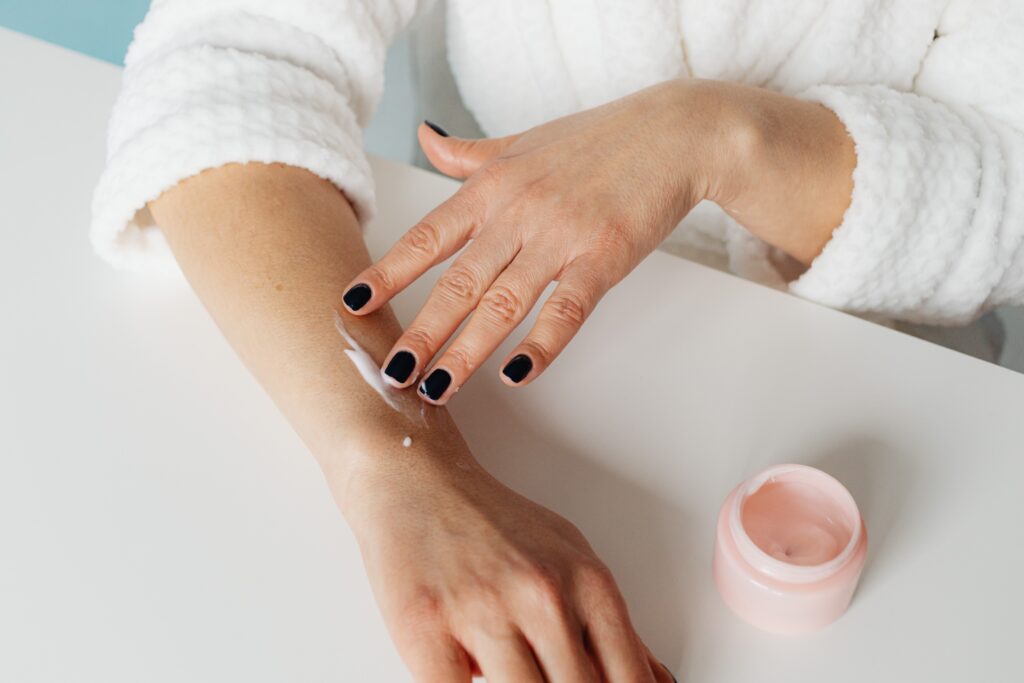Neem is effective on serious Dermatological conditions
Dr. H.S. Puri, a leading clinical research scientist in India made the following statement:
“SKIN CREAMS INCORPORATING NEEM OIL CAN CONTROL PSORIASIS, ECZEMA, ACNE, DERMATITIS AND OTHER SKIN PROBLEMS BETTER THAN ANY OTHER KNOWN PRODUCT”
Neem is clinically proven to be an effective analgesic and anti-inflammatory, relieving both pain and inflammation. These qualities along with the above mentioned properties of Neem is what makes Neem so effective against serious skin conditions like eczema, psoriasis, acne, dermatitis, shingles, jock itch, athletes foot, ring worm, scabies, lice, Candida, and more. Lotions and creams containing Neem oil and Neem leaf extracts are effective externally and Neem leaf extract, capsules, and teas are useful internally because they effectively detoxify the blood of impurities that are the source of skin problems.
Eczema
Eczema also known, as dermatitis is a distressing condition. Individuals with the eczema suffer from dry itchy skin, but in its severe form the skin can become broken and raw. Eczema is not contagious
Almost any part of the skin surface with the exception of protected areas, such as the diaper region, can be involved. When the disease starts in infancy, the rash tends to be localized on the face and scalp. The main problem in eczema is that the skin loses water and dries out causing intense itching. If the child would not scratch, the skin would probably show little or no changes. The scratching is most severe at night and the skin becomes raw and may begin to ooze.
Some known aggravating factors include:
* The frequent use of soaps and other cleansing products that tend to remove natural oil from the skin
* Direct contact with animals (especially their saliva or fur) and indirect contact with animal dander.
* Rapid changes of temperature and humidity.
* Rough, scratchy, or tight clothing, especially clothes made of wool or stiff fabrics.
* Emotional upset can trigger a episode of eczema.
Keeping the fingernails short and using cotton gloves can minimize scratching at night. For infants and younger children, knee-high socks are better than gloves, because they are harder to accidentally pull off during sleep.
Diagnoses
There are several different types of eczema, many of which look similar but have very different causes and treatments. It is very important to see a general practitioner in the first instance, who may make a referral to a specialist dermatologist for further diagnosis.

Topical steroid ointments and creams are frequently used to treat flare-ups of eczema. Steroids are potent drugs. However, these medications can cause significant side effects if used over a long period of time and should be administered only on the advice of the child’s physician.
Atopic eczema
Atopic eczema is the commonest form of eczema and is closely linked with asthma and hayfever. It can affect both children and adults, usually running in families. One of the most common symptoms of atopic eczema is its itchiness (or pruritis), which can be almost unbearable. Other symptoms include overall dryness of the skin, redness and inflammation. Constant scratching can also cause the skin to split, leaving it prone to infection. In infected eczema the skin may crack and weep (‘wet’ eczema).
Allergic contact dermatitis
Develops when the body’s immune system reacts against a substance in contact with the skin. The allergic reaction often develops over a period of time through repeated contact with the substance. For example, an allergic reaction may occur to nickel, which is often found in earrings, belt buckles and jeans buttons. Reactions can also occur after contact with other substances such as perfumes and rubber. In order to prevent repeated reactions it is best to prevent contact with anything that you know causes a rash.
Irritant contact dermatitis
This is a type of eczema caused by frequent contact with everyday substances, such as detergents and chemicals, which are irritating to the skin. It most commonly occurs on the hands of adults and can be prevented by avoiding the irritants and keeping the skin moisturised.
Infantile seborrhoeic eczema
A common condition affecting babies under one year old, the exact cause of which is unknown. Also referred to as cradle cap, it usually starts on the scalp or the nappy area and quickly spreads. Although this type of eczema looks unpleasant, it is not sore or itchy and does not cause the baby to feel uncomfortable or unwell. Normally this type of eczema will clear in just a few months, though the use of moisturizing creams and bath oils can help to speed this along.
Adult seborrhoeic eczema
Characteristically affects adults between the ages of 20 and 40. It is usually seen on the scalp as mild dandruff, but can spread to the face, ears and chest. The skin becomes red, inflamed and starts to flake. This condition is believed to be caused by a yeast growth. If the condition becomes infected, treatment with an anti-fungal cream may be necessary.

Varicose eczema
Varicose eczema affects the lower legs of those in their middle to late years, being caused by poor circulation. Commonly the skin around the ankles is affected, becoming speckled, itchy and inflamed. Treatment is with emollients and steroid creams. If left untreated, the skin can break down, resulting in an ulcer.
Discoid eczema
Is usually found in adults and appears suddenly as a few coin shaped areas of red skin, normally on the trunk or lower legs. They become itchy and can weep fluid. Usually discoid eczema is treated with emollients (and steroid creams if necessary).
Eczema:
In the case of eczema clinical studies demonstrate that even the application of weaker Neem leaf extracts effectively eased the acute conditions of eczema. Using a Soap or shampoo containing Neem oil can easily relieve the itching and redness of eczema. For specific areas of intensity on your skin apply Neem lotion after bathing and/or shampooing with Neem oil products.
Neem has a broad range of beneficial effects has on skin. This makes it one of the better treatments for eczema. Neem moisturizes and protects the skin while it helps heal the lesions, scaling and irritation. It is cooling on the affected areas.
Neem does not have the same side effects as prescribed medications and injections or cause liver damage. It is probably the best and safest alternative for treating eczema. Neem skin cream offers moisturizing, regenerative and restructuring properties to dry and damaged skin.
Treatment:
Bathe in Neem oil and bubble bath; use lotion as needed during the day and Blitz stick for stubborn areas or broken skin.
Suggested Products: – Neem oil, bubble bath, shao shampoo, mist or antiflare lotion. Blitz stick, Neem soap.
